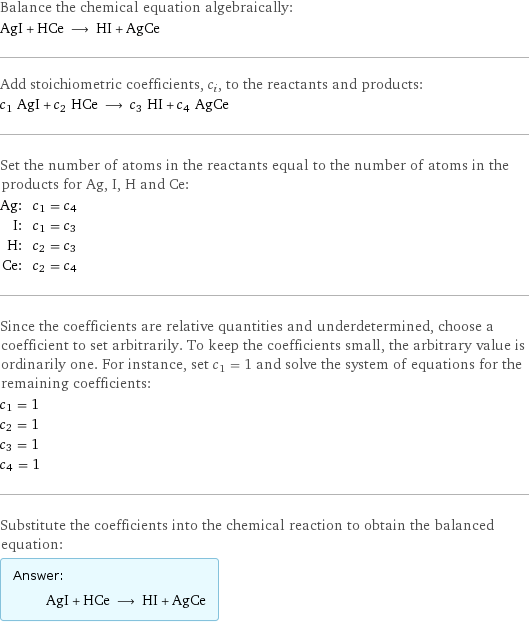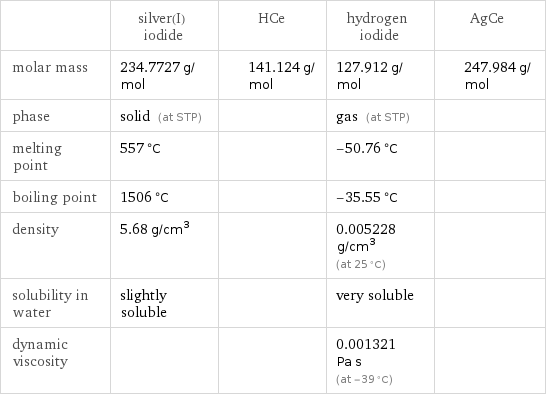Input interpretation

AgI silver(I) iodide + HCe ⟶ HI hydrogen iodide + AgCe
Balanced equation

Balance the chemical equation algebraically: AgI + HCe ⟶ HI + AgCe Add stoichiometric coefficients, c_i, to the reactants and products: c_1 AgI + c_2 HCe ⟶ c_3 HI + c_4 AgCe Set the number of atoms in the reactants equal to the number of atoms in the products for Ag, I, H and Ce: Ag: | c_1 = c_4 I: | c_1 = c_3 H: | c_2 = c_3 Ce: | c_2 = c_4 Since the coefficients are relative quantities and underdetermined, choose a coefficient to set arbitrarily. To keep the coefficients small, the arbitrary value is ordinarily one. For instance, set c_1 = 1 and solve the system of equations for the remaining coefficients: c_1 = 1 c_2 = 1 c_3 = 1 c_4 = 1 Substitute the coefficients into the chemical reaction to obtain the balanced equation: Answer: | | AgI + HCe ⟶ HI + AgCe
Structures

+ HCe ⟶ + AgCe
Names

silver(I) iodide + HCe ⟶ hydrogen iodide + AgCe
Equilibrium constant
![Construct the equilibrium constant, K, expression for: AgI + HCe ⟶ HI + AgCe Plan: • Balance the chemical equation. • Determine the stoichiometric numbers. • Assemble the activity expression for each chemical species. • Use the activity expressions to build the equilibrium constant expression. Write the balanced chemical equation: AgI + HCe ⟶ HI + AgCe Assign stoichiometric numbers, ν_i, using the stoichiometric coefficients, c_i, from the balanced chemical equation in the following manner: ν_i = -c_i for reactants and ν_i = c_i for products: chemical species | c_i | ν_i AgI | 1 | -1 HCe | 1 | -1 HI | 1 | 1 AgCe | 1 | 1 Assemble the activity expressions accounting for the state of matter and ν_i: chemical species | c_i | ν_i | activity expression AgI | 1 | -1 | ([AgI])^(-1) HCe | 1 | -1 | ([HCe])^(-1) HI | 1 | 1 | [HI] AgCe | 1 | 1 | [AgCe] The equilibrium constant symbol in the concentration basis is: K_c Mulitply the activity expressions to arrive at the K_c expression: Answer: | | K_c = ([AgI])^(-1) ([HCe])^(-1) [HI] [AgCe] = ([HI] [AgCe])/([AgI] [HCe])](../image_source/99d75adcf2f92bc2284e5d8f7abe8926.png)
Construct the equilibrium constant, K, expression for: AgI + HCe ⟶ HI + AgCe Plan: • Balance the chemical equation. • Determine the stoichiometric numbers. • Assemble the activity expression for each chemical species. • Use the activity expressions to build the equilibrium constant expression. Write the balanced chemical equation: AgI + HCe ⟶ HI + AgCe Assign stoichiometric numbers, ν_i, using the stoichiometric coefficients, c_i, from the balanced chemical equation in the following manner: ν_i = -c_i for reactants and ν_i = c_i for products: chemical species | c_i | ν_i AgI | 1 | -1 HCe | 1 | -1 HI | 1 | 1 AgCe | 1 | 1 Assemble the activity expressions accounting for the state of matter and ν_i: chemical species | c_i | ν_i | activity expression AgI | 1 | -1 | ([AgI])^(-1) HCe | 1 | -1 | ([HCe])^(-1) HI | 1 | 1 | [HI] AgCe | 1 | 1 | [AgCe] The equilibrium constant symbol in the concentration basis is: K_c Mulitply the activity expressions to arrive at the K_c expression: Answer: | | K_c = ([AgI])^(-1) ([HCe])^(-1) [HI] [AgCe] = ([HI] [AgCe])/([AgI] [HCe])
Rate of reaction
![Construct the rate of reaction expression for: AgI + HCe ⟶ HI + AgCe Plan: • Balance the chemical equation. • Determine the stoichiometric numbers. • Assemble the rate term for each chemical species. • Write the rate of reaction expression. Write the balanced chemical equation: AgI + HCe ⟶ HI + AgCe Assign stoichiometric numbers, ν_i, using the stoichiometric coefficients, c_i, from the balanced chemical equation in the following manner: ν_i = -c_i for reactants and ν_i = c_i for products: chemical species | c_i | ν_i AgI | 1 | -1 HCe | 1 | -1 HI | 1 | 1 AgCe | 1 | 1 The rate term for each chemical species, B_i, is 1/ν_i(Δ[B_i])/(Δt) where [B_i] is the amount concentration and t is time: chemical species | c_i | ν_i | rate term AgI | 1 | -1 | -(Δ[AgI])/(Δt) HCe | 1 | -1 | -(Δ[HCe])/(Δt) HI | 1 | 1 | (Δ[HI])/(Δt) AgCe | 1 | 1 | (Δ[AgCe])/(Δt) (for infinitesimal rate of change, replace Δ with d) Set the rate terms equal to each other to arrive at the rate expression: Answer: | | rate = -(Δ[AgI])/(Δt) = -(Δ[HCe])/(Δt) = (Δ[HI])/(Δt) = (Δ[AgCe])/(Δt) (assuming constant volume and no accumulation of intermediates or side products)](../image_source/9c9e6bd716e869e6a6b3e85d3cff6850.png)
Construct the rate of reaction expression for: AgI + HCe ⟶ HI + AgCe Plan: • Balance the chemical equation. • Determine the stoichiometric numbers. • Assemble the rate term for each chemical species. • Write the rate of reaction expression. Write the balanced chemical equation: AgI + HCe ⟶ HI + AgCe Assign stoichiometric numbers, ν_i, using the stoichiometric coefficients, c_i, from the balanced chemical equation in the following manner: ν_i = -c_i for reactants and ν_i = c_i for products: chemical species | c_i | ν_i AgI | 1 | -1 HCe | 1 | -1 HI | 1 | 1 AgCe | 1 | 1 The rate term for each chemical species, B_i, is 1/ν_i(Δ[B_i])/(Δt) where [B_i] is the amount concentration and t is time: chemical species | c_i | ν_i | rate term AgI | 1 | -1 | -(Δ[AgI])/(Δt) HCe | 1 | -1 | -(Δ[HCe])/(Δt) HI | 1 | 1 | (Δ[HI])/(Δt) AgCe | 1 | 1 | (Δ[AgCe])/(Δt) (for infinitesimal rate of change, replace Δ with d) Set the rate terms equal to each other to arrive at the rate expression: Answer: | | rate = -(Δ[AgI])/(Δt) = -(Δ[HCe])/(Δt) = (Δ[HI])/(Δt) = (Δ[AgCe])/(Δt) (assuming constant volume and no accumulation of intermediates or side products)
Chemical names and formulas

| silver(I) iodide | HCe | hydrogen iodide | AgCe formula | AgI | HCe | HI | AgCe name | silver(I) iodide | | hydrogen iodide | IUPAC name | silver iodide | | hydrogen iodide |
Substance properties

| silver(I) iodide | HCe | hydrogen iodide | AgCe molar mass | 234.7727 g/mol | 141.124 g/mol | 127.912 g/mol | 247.984 g/mol phase | solid (at STP) | | gas (at STP) | melting point | 557 °C | | -50.76 °C | boiling point | 1506 °C | | -35.55 °C | density | 5.68 g/cm^3 | | 0.005228 g/cm^3 (at 25 °C) | solubility in water | slightly soluble | | very soluble | dynamic viscosity | | | 0.001321 Pa s (at -39 °C) |
Units
